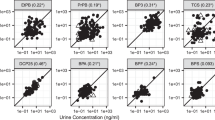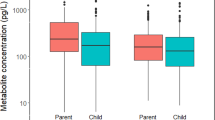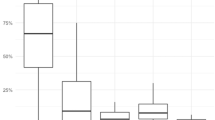Abstract
The longitudinal NHEXAS-Maryland study measured metals, PAHs, and pesticides in several media to capture temporal variability. Questionnaires were concurrently administered to identify factors that influenced changes in contaminant levels over time. We constructed mixed-effects regression models for lead, phenanthrene, and chlorpyrifos (including metabolites) in indoor air, dust, dermal wipes, and biological fluids. Significant predictors represented time-varying activities as well as unchanging housing and demographic factors. There was little overlap among the models, with predictors generally reflecting the diverse characteristics of the target compounds. We estimated between- and within-person variance components to evaluate the reliability of the measurements. While only one measurement of lead in blood or chlopyrifos in dust was needed for a dependable estimate of an individual's average level, three to eight measurements were needed for most other compound/exposure medium combinations because of considerable temporal variability. Measurements in biological fluids and dust were generally more consistent than those in indoor air. The significant covariates in the full models preferentially reduced the between-person variance component. Since the regression models explained only 1–37% of the within-person variance, the questionnaires in this study provided only modest insight into the factors responsible for the temporal variability in the contaminant levels.
This is a preview of subscription content, access via your institution
Access options
Subscribe to this journal
Receive 6 print issues and online access
$259.00 per year
only $43.17 per issue
Buy this article
- Purchase on Springer Link
- Instant access to full article PDF
Prices may be subject to local taxes which are calculated during checkout
Similar content being viewed by others
References
Alessio L., Berlin A., Dell’Orto A., Toffoletto F., and Ghezzi I. Reliability of urinary creatinine as a parameter used to adjust values of urinary biological indicators. Int Arch Occup Environ Health 1985: 55: 99–106.
ATSDR (Agency for Toxic Substances and Disease Registry). Toxicological Profile for Naphthalene (update). ASTDR, Atlanta, GA, 1995.
Berkowitz G.S., Obel J., Deych E., Lapinski R., Godbold J., Liu Z., Landrigan P.J., and Wolff M.S. Exposure to indoor pesticides during pregnancy in a multiethnic, urban cohort. Environ Health Perspect 2003: 111(1): 79–84.
Burstyn I., Kromhout H., Kauppinen T., Heikkila P., and Boffetta P. Statistical modelling of the determinants of historical exposure to bitumen and polycyclic aromatic hydrocarbons among paving workers. Ann Occup Hyg 2000: 44: 43–56.
Clayton C., Pellizzari E., and Quackenboss J. National Human Exposure Assessment Survey: analysis of exposure pathways and routes for arsenic and lead in EPA Region 5. J Expo Anal Environ Epidemiol 2002: 12(1): 29–43.
Clayton C.A., Pellizzari E.D., Whitmore R.W., Perritt R.L., and Quackenboss J.J. National Human Exposure Assessment Survey (NHEXAS): distributions and associations of lead, arsenic and volatile organic compounds in EPA region 5. J Expo Anal Environ Epidemiol 1999: 9(5): 381–392.
Clayton C.A., Pellizzari E.D., Whitmore R.W., Quackenboss J.J., Adgate J., and Sexton K. Distributions, associations, and partial aggregate exposure of pesticides and polynuclear aromatic hydrocarbons in the Minnesota Children's Pesticide Exposure Study (MNCPES). J Expo Anal Environ Epidemiol 2003: 13(2): 100–111.
Cohen Jr A.C. Simplified estimators for the normal distribution when samples are singly censored or truncated. Technometrics 1959: 1: 217–237.
Echols S.L., MacIntosh D.L., Hammerstrom K.A., and Ryan P.B. Temporal variability of microenvironmental time budgets in Maryland. J Expo Anal Environ Epidemiol 1999: 9(5): 502–512.
Echols S.L., Macintosh D.L., and Ryan P.B. Temporal patterns of activities potentially related to pesticide exposure. J Expo Anal Environ Epidemiol 2001: 11(5): 389–397.
Egeghy P.P., Nylander-French L., Gwin K.K., Hertz-Picciotto I., and Rappaport S.M. Self-collected breath sampling for monitoring low-level benzene exposures among automobile mechanics. Ann Occup Hyg 2002: 46(5): 489–500.
Elovaara E., Vaananen V., and Mikkola J. Simultaneous analysis of naphthols, phenanthrols, and 1-hydroxypyrene in urine as biomarkers of polycyclic aromatic hydrocarbon exposure: intraindividual variance in the urinary metabolite excretion profiles caused by intervention with b-naphthoflavone induction in the rat. Arch Toxicol 2003: 77: 183–193.
Fleiss J.L. The Design and Analysis of Clinical Experiments. John Wiley & Sons, New York, NY, 1985.
Hilts S.R. Effect of smelter emission reductions on children's blood lead levels. Sci Total Environ 2003: 303(1–2): 51–58.
Hughes M.D. Analysis and design issues for studies using censored biomarker measurements with an example of viral load measurements in HIV clinical trials. Statist Med 2000: 19: 3171–3191.
Kromhout H., Symanski E., and Rappaport S.M. A comprehensive evaluation of within- and between-worker components of occupational exposure to chemical agents. Ann Occup Hyg 1993: 37: 253–270.
Lebowitz M.D. Exposure assessment needs in studies of acute health effects. Sci Total Environ 1995: 168(2): 109–117.
Leech J.A., Nelson W.C., Burnett R.T., Aaron S., and Raizenne M.E. It's about time: a comparison of Canadian and American time-activity patterns. J Expo Anal Environ Epidemiol 2002: 12(6): 427–432.
Lemasters G.K., Shukla R., Li Y.D., and Lockey J.E. Balancing cost and precision in exposure assessment studies. J Occup Environ Med 1996: 38(1): 39–45.
Lewis R.G., Fortune C.R., Blanchard F.T., and Camann D.E. Movement and deposition of two organophosphorus pesticides within a residence after interior and exterior applications. J Air Waste Manag Assoc 2001: 51(3): 339–351.
Littell R.C., Milliken G.A., Stroup W.W., and Wolfinger R.D. SAS System for Mixed Models. SAS Institute Inc., Cary, NC, 1996, 633pp.
MacIntosh D.L., Hammerstorm K.A., and Ryan P.B. Longitudinal exposure to selected pesticides in drinking water. Hum Ecol Risk Assess 1999a: 5(3): 575–588.
MacIntosh D.L., Kabiru C., Scanlon K.A., and Ryan P.B. Longitudinal investigation of exposure to arsenic, cadmium, chromium and lead via beverage consumption. J Expo Anal Environ Epidemiol 2000: 10(2): 196–205.
MacIntosh D.L., Kabiru C., Echols S.L., and Ryan P.B. Dietary exposure to chlorpyrifos and levels of 3,5,6-trichloro-2-pyridinol in urine. J Expo Anal Environ Epidemiol 2001a: 11(4): 279–285.
MacIntosh D.L., Kabiru C.W., and Ryan P.B. Longitudinal investigation of dietary exposure to selected pesticides. Environ Health Perspect 2001b: 109(2): 145–150.
MacIntosh D.L., Needham L.L., Hammerstrom K.A., and Ryan P.B. A longitudinal investigation of selected pesticide metabolites in urine. J Expo Anal Environ Epidemiol 1999b: 9(5): 494–501.
Malcoe L.H., Lynch R.A., Keger M.C., and Skaggs V.J. Lead sources, behaviors, and socioeconomic factors in relation to blood lead of Native American and White children: a community-based assessment of a former mining area. Environ Health Perspect 2002: 110(Suppl 2): 221–231.
Malkin R., Brandt-Rauf P., Graziano J., and Parides M. Blood lead levels in incinerator workers. Environ Res 1992: 59(1): 265–270.
Meyer I., Heinrich J., and Lippold U. Factors affecting lead and cadmium levels in house dust in industrial areas of eastern Germany. Sci Total Environ 1999: 234(1–3): 25–36.
Moschandreas D.J., Kimm Y., Karuchit S., Ari H., Lebowitz M.D., O’Rourke M.K., Gordon S., and Robertson G. In-residence, multiple route exposures to chlorpyrifos and diazinon estimated by indirect method models. Atmos Environ 2001: 35: 2201–2213.
NCEH (National Center for Environmental Health). Second National Report on Human Exposure to Environmental Chemicals. Department of Health and Human Services, Centers for Disease Control and Prevention, National Center for Environmental Health, Division of Laboratory Sciences, Atlanta, GA, 2003; NCEH Pub. No. 02-0716.
Naumova Y.Y., Eisenreich S.J., Turpin B.J., Weisel C.P., Morandi M.T., Colome S.D., Totten L.A., Stock T.H., Winer A.M., Alimokhtari S., Kwon J., Shendell D., Jones J., Maberti S., and Wall S.J. Polycyclic aromatic hydrocarbons in the indoor and outdoor air of three cities in the US. Environ Sci Technol 2002: 36(12): 2552–2559.
Pang Y., MacIntosh D.L., Camann D.E., and Ryan P.B. Analysis of aggregate exposure to chlorpyrifos in the NHEXAS-Maryland investigation. Environ Health Perspect 2002: 110(3): 235–240.
Pang Y., MacIntosh D.L., and Ryan P.B. A longitudinal investigation of aggregate oral intake of copper. J Nutr 2001: 131(8): 2171–2176.
Pirkle J.L., Kaufmann R.B., Brody D.J., Hickman T., Gunter E.W., and Paschal D.C. Exposure of the US population to lead, 1991–1994. Environ Health Perspect 1998: 106: 745–750.
Rappaport S.M. Assessment of long-term exposures to toxic substances in air (review). Ann Occup Hyg 1991: 35(1): 61–121.
Rappaport S.M., Symanski E., Yager J.W., and Kupper L.L. The relationship between environmental monitoring and biological markers in exposure assessment. Environ Health Perspect 1995: 103(Suppl 3): 49–54.
Rhoads G.G., Ettinger A.S., Weisel C.P., Buckley T.J., Goldman K.D., Adgate J., and Lioy P.J. The effect of dust lead control on blood lead in toddlers: a randomized trial. Pediatrics 1999: 103(3): 551–555.
Ryan P.B., Huet N., and MacIntosh D.L. Longitudinal investigation of exposure to arsenic, cadmium, and lead in drinking water. Environ Health Perspect 2000: 108(8): 731–735.
Ryan P.B., Scanlon K.A., and MacIntosh D.L. Analysis of dietary intake of selected metals in the NHEXAS-Maryland investigation. Environ Health Perspect 2001: 109(2): 121–128.
Scanlon K.A., MacIntosh D.L., Hammerstrom K.A., and Ryan P.B. A longitudinal investigation of solid-food based dietary exposure to selected elements. J Expo Anal Environ Epidemiol 1999: 9(5): 485–493.
Simcox N.J., Fenske R.A., Wolz S.A., Lee I.C., and Kalman D.A. Pesticides in household dust and soil: exposure pathways for children of agricultural families. Environ Health Perspect 1995: 103(12): 1126–1134.
Stout D.M., and Mason M.A. The distribution of chlorpyrifos following a crack and crevice type application in the US EPA Indoor Air Quality Research House. Atmos Environ 2003: 37(39–40): 5539–5549.
Symanski E., Bergamaschi E., and Mutti A. Inter- and intra-individual sources of variation in levels of urinary styrene metabolites. Int Arch Occup Environ Health 2001: 74(5): 336–344.
Tee P.G., Sweeney A.M., Symanski E., Gardiner J.C., Gasior D.M., and Schantz S.L. A longitudinal examination of factors related to changes in serum polychlorinated biphenyl levels. Environ Health Perspect 2003: 111(5): 702–707.
Whyatt R.M., Barr D.B., Camann D.E., Kinney P.L., Barr J.R., Andrews H.F., Hoepner L.A., Garfinkel R., Hazi Y., Reyes A., Ramirez J., Cosme Y., and Perera F.P. Contemporary-use pesticides in personal air samples during pregnancy and blood samples at delivery among urban minority mothers and newborns. Environ Health Perspect 2003: 111(5): 749–756.
Williams R., Ryan P.B., Hern S., Kildosher L., and Witherspoon C. Personal exposures to polycyclic aromatic hydrocarbons associated with the NHEXAS pilot. Presented at the International Society for Exposure Analysis 2001 Annual Conference. Charleston, South Carolina, November 4–8, 2001.
Zayed S.M., Farghaly M., and El-Maghraby S. Fate of 14C-chlorpyrifos in stored soybeans and its toxicological potential to mice. Food Chem Toxicol 2003: 41(6): 767–772.
Acknowledgements
The US Environmental Protection Agency through its Office of Research and Development funded, managed, and collaborated in the research described here under NHEXAS Cooperative Agreement no. CR822038-1 to Harvard University, Johns Hopkins University, Emory University, Southwest Research Institute, and Westat. It has been subjected to Agency review and approved for publication. We thank Michael Dellarco of the US EPA National Center for Environmental Assessment and Mark Weaver of Family Health International for their valuable advice and assistance.
Author information
Authors and Affiliations
Corresponding author
Additional information
Supplementary Information accompanies the paper on Journal of Exposure Analysis and Environmental Epidemiology website (http://www.nature.com/jea)
Supplementary information
Rights and permissions
About this article
Cite this article
Egeghy, P., Quackenboss, J., Catlin, S. et al. Determinants of temporal variability in NHEXAS-Maryland environmental concentrations, exposures, and biomarkers. J Expo Sci Environ Epidemiol 15, 388–397 (2005). https://doi.org/10.1038/sj.jea.7500415
Received:
Accepted:
Published:
Issue Date:
DOI: https://doi.org/10.1038/sj.jea.7500415
Keywords
This article is cited by
-
Spatio-temporal assessment of pregnant women exposure to chlorpyrifos at a regional scale
Journal of Exposure Science & Environmental Epidemiology (2022)
-
Simulating exposure-related behaviors using agent-based models embedded with needs-based artificial intelligence
Journal of Exposure Science & Environmental Epidemiology (2020)
-
Calibrating an agent-based model of longitudinal human activity patterns using the Consolidated Human Activity Database
Journal of Exposure Science & Environmental Epidemiology (2020)
-
Distribution, Sources and Health Risks of Polycyclic Aromatic Hydrocarbons (PAHs) in Household Dusts from Rural, Semi-urban and Urban Areas in the Niger Delta, Nigeria
Exposure and Health (2019)
-
Human Exposure Assessment of Airborne Pollutants for Residents in Gwangyang City Near Industrial Plants (I)
Toxicology and Environmental Health Sciences (2018)



